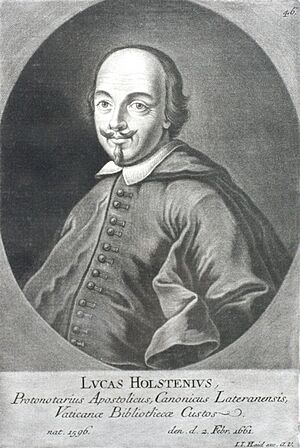Lucas Holstenius facts for kids
Lucas Holstenius (born Lukas Holste, 1596 – 1661) was a very smart German scholar. He was a Catholic humanist, which means he loved studying ancient Greek and Roman culture. He was also a geographer (someone who studies maps and places), a historian (someone who studies the past), and a librarian (someone who works with books in a library). He spent most of his life in Italy, especially in Rome.
Contents
A Scholar's Journey
Lucas Holstenius was born in Hamburg, Germany, in 1596. He was a brilliant student from a young age. He first studied in Hamburg and then at Leiden University in the Netherlands. There, he met many famous scholars of his time.
Early Travels and Studies
In 1618, Lucas traveled to Italy and Sicily with his friend Philip Cluverius. This trip made him very interested in studying geography. When he returned, he hoped to get a job in Hamburg, but he didn't succeed. So, he decided to leave Germany for good.
From 1622 to 1624, he spent two years in England, visiting Oxford and London. While there, he collected information for one of his big projects, a book called Geographi Minores. After England, he moved to Paris, France.
Life in Paris and Rome
In Paris, in 1624, Lucas became the librarian for a very important person, President de Mesmes. During this time, he decided to become a Catholic. He was likely influenced by reading old religious writings from Greek and Latin scholars.
In 1627, Lucas moved to Rome, Italy. There, he joined the household of Cardinal Francesco Barberini. Cardinal Barberini had one of the most important private libraries in Rome. By 1636, Lucas became the Cardinal's main librarian. Some of Lucas's own book collection is now kept in the Biblioteca Angelica in Rome.
Working for the Popes
Later, Lucas Holstenius was put in charge of the famous Vatican Library under Pope Innocent X. The popes often sent him on important missions. For example, he carried a cardinal's hat to a church official in Warsaw in 1629.
Pope Alexander VII even sent him to Innsbruck to meet Christina, Queen of Sweden. She was giving up her Protestant faith to become Catholic. Lucas also helped other important people convert to Catholicism.
His Big Ideas
Most of the time, Lucas was busy with his studies. He had many huge plans for books and research. He was incredibly hardworking and knew a lot about many subjects. However, he sometimes struggled to finish all the big projects he started.
He wanted to correct and finish a geography book by his friend Philip Cluver. He also planned to edit and translate ancient Greek writings. He wanted to collect old religious speeches and gather historical inscriptions. He even dreamed of writing a detailed study of the Greek Bible.
These many projects took up all his energy. He filled many notebooks with his ideas and research. Even though he didn't finish everything, his notes and collections were very useful to other scholars later on. Lucas Holstenius passed away in Rome on February 2, 1661.
His Published Works
Even though Lucas Holstenius had many unfinished projects, he still published several important works.
Key Publications
- He added notes to Cluver's Italia antiqua (1624), a book about ancient Italy.
- He edited parts of the writings of Porphyry (1630), an ancient philosopher. He also wrote about Porphyry's life.
- He added notes to other ancient texts, like Eusebius Against Hierocles (1628) and the Sayings of the later Pythagoreans (1638).
- He also edited De diis et mundo (1638) by the philosopher Sallustius.
- In 1644, he edited Arrian's book about hunting.
- One of his most famous works was the Codex regularum monasticarum (1661). This was a collection of rules for monks and nuns. It also included the first printing of a text called De admonitio ad filium spiritualem.
Rediscovering Ancient Texts
Lucas Holstenius also found and edited the Liber Diurnus Romanorum Pontificum (1660) for the first time. This was a collection of old official documents and forms used by the Roman Church. However, Pope Alexander VII quickly stopped its publication.
He was also the first person to figure out the exact location of Horace's fanum Vacunae. This was an ancient shrine mentioned by the Roman poet Horace. Lucas found it was the shrine of Victoria in Roccagiovine, thanks to an old stone carving found there.
Works Published After His Death
After Lucas died, some of his papers were published. These included collections of church meetings and religious documents. They were called Collectio romana bipartita (1662). Also published were stories of Christian martyrs like Perpetua and Felicitas, Boniface, and Tarachus, Probus and Andronicus (1663). Another work was Notae et castigationes in Stephan Byzantini ethnica (1684).


